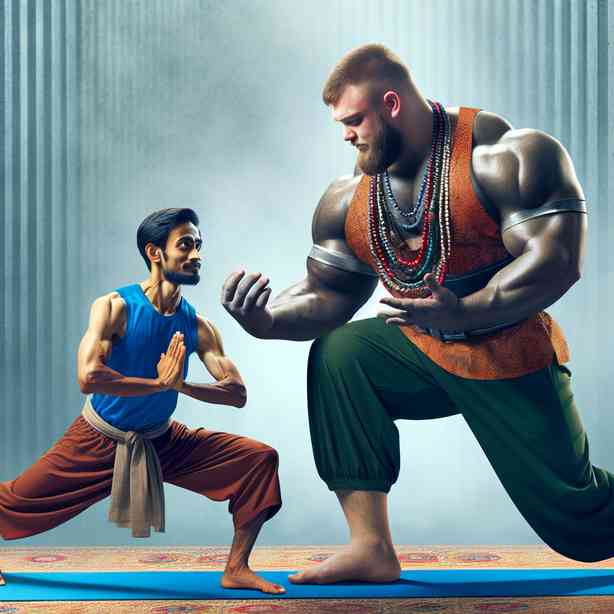
Powerlifting and yoga occupy two distinct realms within the fitness community, often attracting different types of individuals with unique goals. Powerlifting, a strength sport consisting of three main lifts—squat, bench press, and deadlift—focuses on maximizing an athlete’s strength in short, intense bursts. Practitioners of this sport often seek to achieve personal records, cultivate muscle mass, and improve their overall power output. In contrast, yoga emphasizes flexibility, mindfulness, and the connection between body and mind through various poses and breathing techniques. This duality sets the stage for a captivating exploration of how yoga can humble even the most seasoned powerlifter.
A powerlifter’s journey is one filled with dedication, discipline, and a relentless pursuit of strength. Every day in the gym is a lesson in grit; lifting heavy weights requires not just physical strength but also mental fortitude. Many powerlifters train under strict regimens, competing against themselves and others to continuously improve their total lift. They often pride themselves on their ability to lift extraordinary weights, pushing their bodies to the limit.
However, this singular focus on strength can come at a cost. Powerlifters may neglect flexibility, balance, and mobility—elements that are crucial for overall athleticism and injury prevention. It is not uncommon for those in the powerlifting community to experience tightness and discomfort, particularly in their hips, lower back, and shoulders. This is where yoga can play a transformative role, offering a counterbalance to the heavy lifting.
Incorporating yoga into a powerlifter’s training routine can provide numerous benefits. The stretching and mobility work inherent in yoga can help alleviate tightness and improve overall flexibility. This is vital for powerlifters, as maintaining a proper range of motion can enhance technique and ultimately lead to better lifts. For instance, a deeper squat necessitates significant ankle and hip flexibility, which yoga can help develop. Additionally, many yoga poses strengthen the core and stabilizing muscles—important areas often overlooked during heavy lifts.
Moreover, yoga’s emphasis on mindfulness and breathing can alleviate the mental strain that accompanies intense training. Powerlifting often comes with its own set of pressures; the competitive nature of the sport can create anxiety that may impact performance. Through mindful breathing practices and meditation, yoga teaches individuals to become more aware of their mental state, facilitating a sense of calm and focus. This mental clarity can enhance performance during lifts, helping powerlifters remain composed and confident under the barbell.
As powerlifters begin to embrace their yoga practice, it is common to experience an awakening of sorts. The humbling aspect of yoga lies in its ability to expose limitations. For those accustomed to lifting heavy weights, it can be an eye-opener to find themselves challenged by yoga poses that demand balance, stability, and flexibility. Warrior II, for example, requires a strong foundation and a surprising degree of coordination that a powerlifter may not typically utilize. The initial struggle with such poses can serve as a reminder that strength is not solely about muscle but involves a holistic approach to athleticism.
As powerlifters witness their own limitations through yoga, they may also learn to appreciate the strength present in vulnerability. Giving oneself permission to fall out of a pose, or to acknowledge the need to work on flexibility, fosters an environment of growth. This shift in mindset can prove incredibly beneficial, as it encourages powerlifters to adopt a more well-rounded approach to their training. Instead of merely focusing on numbers, they start to recognize the importance of alignment, body awareness, and even recovery.
Furthermore, many powerlifters report improvements in their overall mood and well-being after integrating yoga into their regimen. The physical practice of yoga releases endorphins, which can create feelings of happiness and reduce stress. This is further compounded by the meditative aspects of yoga which promote mental clarity and emotional resilience. Powerlifters, who often experience the psychological pressures of competing and constantly striving for personal bests, can find solace in the restorative nature of yoga.
In the shared space of yoga, powerlifters may also discover a community that values different strengths. This environment allows them to connect with individuals who prioritize flexibility and balance over sheer muscle. Such interactions can foster mutual respect and understanding, leading to beneficial cross-training opportunities. Many experienced yogis appreciate the power and intensity that powerlifters bring to the table, while powerlifters can admire the grace and poise of yoga practitioners. This blending of communities can lead to valuable partnerships, workshops, and collaborative training sessions that enrich the experience of both philosophies.
The combination of yoga and powerlifting also underscores the idea that fitness is not a one-size-fits-all endeavor. Each individual has unique needs and goals, and a hybrid approach can cater to diverse fitness pursuits. By allowing yoga to humble them, powerlifters can embrace a more integrative training regimen that encompasses strength, flexibility, and mindfulness. This multifaceted approach promotes longevity in the sport, reducing the risk of injury while enhancing performance.
Ultimately, the story of a powerlifter who embraces yoga is one of transformation. It represents the journey from strength to humility and the realization that true athleticism is defined not just by the weight lifted, but by the awareness of one’s body and mind. As powerlifters begin to respect their limits and explore the intricacies of their movement patterns through yoga, they find that their passion for strength can coexist beautifully with a greater understanding of balance and flexibility.
In conclusion, the relationship between powerlifting and yoga serves as a reminder that fitness is a dynamic and evolving journey. Yoga has the potential to humble even the strongest among us, unveiling the profound intricacies of movement and mental clarity. This integration cultivates a sense of wholeness, encouraging individuals to become not just stronger, but also more adaptable and resilient. Those willing to explore both worlds may find that they emerge as well-rounded athletes, ready to conquer challenges—both on and off the platform—while appreciating the multifaceted nature of human capability.


